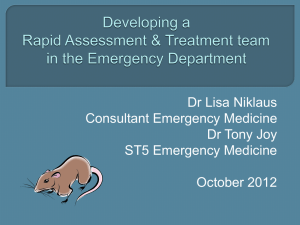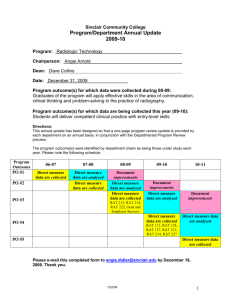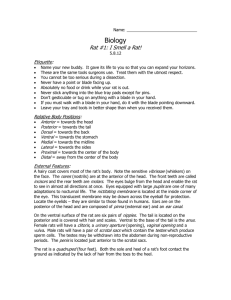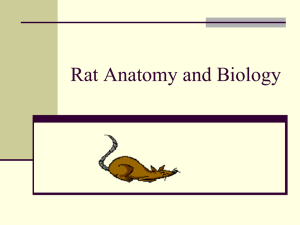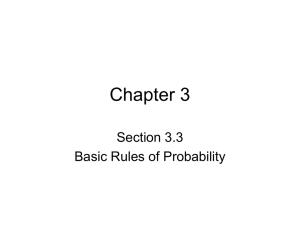Effective Approaches in Urgent and Emergency Care
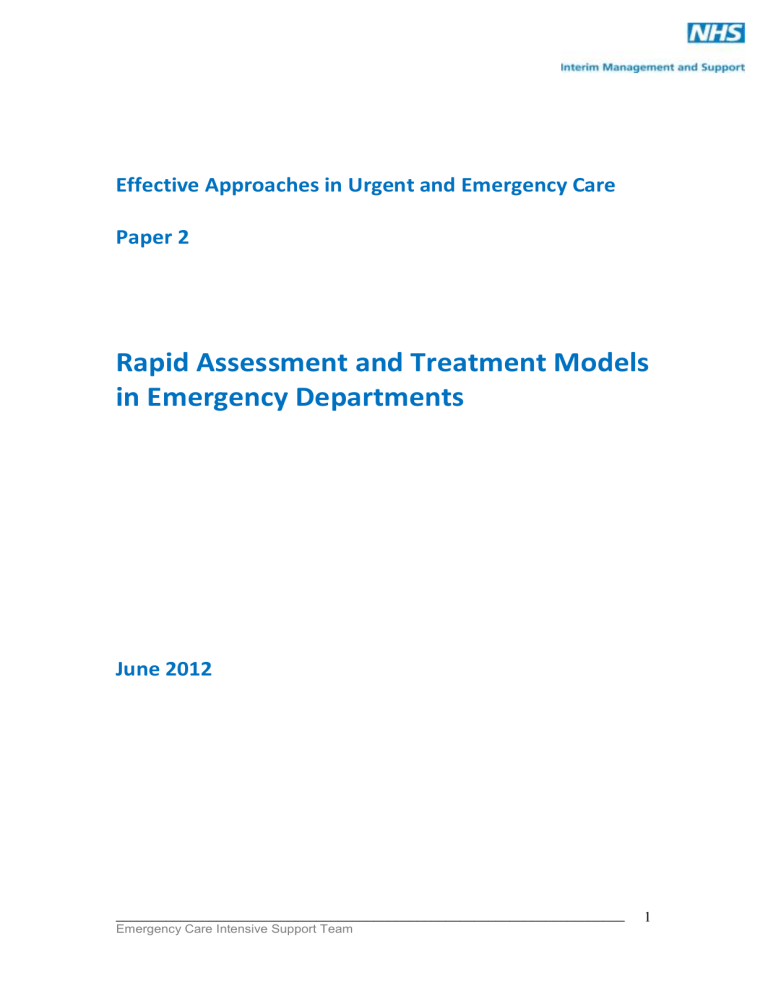
Effective Approaches in Urgent and Emergency Care
Paper 2
Rapid Assessment and Treatment Models in Emergency Departments
June 2012
_______________________________________________________________________
Emergency Care Intensive Support Team
1
Rapid Assessment and Treatment (RAT) models in
Emergency Departments
The Pros and Cons of RAT
In our paper, ‘Priorities within Acute Hospitals’, we suggested that emergency departments consider implementing Rapid Assessment and Treatment (RAT) models.
The aim of RAT is to provide early senior assessment of undifferentiated ‘majors’ patients. The model has been implemented by a number of emergency departments, with considerable benefits to patient safety and satisfaction. The model also provides a means by which EDs can achieve both their ‘time to assessment’ and
‘time to treatment’ indicators.
RAT is not, however, a panacea and implementation can be difficult, particularly in poorly staffed departments. Senior clinicians who lead RAT teams can find the intensity of work a challenge. Poor flow out of the ED can also present a challenge – rapidly assessing a patient to require admission can be frustrating if no bed is available.
This short guide outlines the principles behind RAT, suggests practical steps to implement the approach and gives some real-life examples. We also discuss the practical problems that need to be taken into consideration when implementing the model.
What is RAT?
RAT typically involves the early assessment of ‘majors’ patients in ED, by a team led by a senior doctor, with the initiation of investigations and/or treatment.
The approach consciously removes ‘triage’ and initial junior medical assessment from the pathway. Instead, the first doctor a patient sees is one who is able to make a competent initial assessment, define a care plan and make a decision whether the patient requires admission or referral to an in-taking specialist team. Nurses and junior doctors in the RAT team then implement the first stages of the care plan.
The advantages of this approach include:
Queues for triage and waits after triage are eliminated;
Value-adding steps in the patient journey are commenced earlier;
Clinical resources previously tied up in triage can be re-tasked to provide value-adding care;
_______________________________________________________________________
Emergency Care Intensive Support Team
2
Unnecessary investigations and tests are reduced due to early senior clinician input;
Subsequent junior medical assessment is directed by the care plan;
Patients for admission are identified earlier and can leave the department more quickly;
The clinical risk associated with undifferentiated patients waiting for senior review is reduced;
Senior clinicians gain an overview of patients entering the department;
Time critical treatments and investigations are initiated early (e.g. antibiotics in sepsis or CT-head where indicated in head injury);
Outcomes and the patient experience are greatly improved.
Junior doctors learn by example.
The Challenges of RAT:
RAT is very demanding in terms of senior medical input. Most departments do not run RAT 24-hours a day. Experience suggests that RAT run during more limited, core hours, can be effective and deliver considerable benefits.
Most systems focus RAT on ambulance patients. It is important to ensure the pathway can also meet the needs of ‘walk-ups’ who present with serious illnesses.
Not all ambulance patients require a senior medical review – pathways must be flexible enough to stream patients whatever their point of entry.
Bias and error of early assessment may be carried through into majors. A culture of constructive challenge to early decisions should be encouraged.
The impact of RAT on the training of junior doctors needs to be considered and allowed for, although supervised practice is usually more educationally effective that unsupervised trial and error.
RAT is mentally demanding - this needs to be taken into account when planning rotas. Some rotas have a two-hours on, two-hours off approach.
RAT models
A number of local RAT models have developed over recent years, all of which aim to provide early assessment and the start of treatment for ‘majors’ arrivals. Typically,
RAT has three potential outcomes:
1.
An intervention completely contained within the emergency department, with discharge home/to GP or follow up (including ambulatory emergency care).
2.
Referral to an in-taking speciality for admission, with or without initial investigations.
3.
Transfer to an alternative provider, service or facility.
An essential component of all models is ‘internal professional standards’ that define the times within which various interventions take place. For example, some departments have decided that ‘time from arrival to RAT’ should not exceed 15
_______________________________________________________________________
Emergency Care Intensive Support Team
3
minutes; ‘time from RAT to decision to admit’ should not exceed 2 hours; and ‘time for imaging requests to be completed’ should not exceed 1 hour. By setting and measuring such standards, bottlenecks can be identified and performance requirements clearly understood by team leaders.
RAT teams typically consist of a senior doctor (a consultant or a senior middle grade); a junior doctor; a qualified nurse; an HCA and sometimes a dedicated porter and clerical staff.
In order to function effectively, RAT models depend on team-work and clear communication. The RAT team should be resourced with all necessary equipment
(e.g. ECG machines) to help inform clinical decision-making and risk-management.
Following assessment and initiation of treatment, patients are typically transferred to the care of the ‘majors’ team in the department. Hand-over using SBAR or similar tools is, of course, important.
It is essential for any model to consider infection control (for example diarrhoea,
MRSA, neutropenic sepsis) as these patients may need to bypass RAT but still need immediate assessment.
Figure 1
RAT design principles
*Assemble a multidisciplinary team to design your local model of rapid assessment –
including non-clinical support staff – and communicate your plans and intentions.
*Use a “model for improvement” (e.g. PDSA) to test out your ideas and plans
*Design rotas to avoid clinician exhaustion
*Introduce a standard clerking proforma and documentation to support your model
*Measure time to treatment and other metrics before and after implementation
*Project-manage the implementation of your local model
*Ensure rapid access to diagnostics
*Allocate dedicated equipment to the RAT team
*Design a system that can flex to demand
*Introduce internal professional standards for response time to support speedy referral
*Consider implementing rapid assessment into assessment units
_______________________________________________________________________
Emergency Care Intensive Support Team
4
Case Studies
Case Study 1
This case study describes a RAT model in a London Trust commenced in 2010 that focuses on ambulance patients.
The specific aims of the RAT team are to:
Perform a rapid assessment of all ambulance arrivals to ED within 15– this did not constitute a full patient clerking
Formulate a senior clinician-led management plan and initiate:
Appropriate investigations – bloods, ECG, x rays, urinalysis, CT
Early treatment – analgesia, antibiotics, intravenous infusion
Risk stratification: to identify patients for escalated care (i.e. resus’) and de-escalated care (e.g. transfer to the co-located urgent care centre, or discharge)
Fast-track of patients directly to inpatient specialty teams where the diagnosis was clear and investigations and management steps completed.
Early identification of patients likely to need admission, and prompt bed requests
Where possible, provide a secondary assessment of triaged ambulatory patients and expedite investigations and treatment.
Fast-track patients to specific pathways (e.g. Clinical Decision Unit )
The RAT team consists of:
A senior doctor (consultant or registrar >ST4 or ‘RAT signed-off’)
A band 5 nurse
An HCA
A Porter
A band 4 receptionist / coordinator to manage beds / flow.
Each RAT team works in four hour ‘RAT shifts’ and is operational between 12 midday and 8pm and longer where possible.
Close teamwork is essential to the functioning of the RAT system. Traditional work boundaries have been relaxed, so that the first available team-member undertakes any outstanding tasks in order to maintain patient flow (e.g. preparing cubicles, taking bloods etc.)
All RAT episodes are aimed to be completed within 20 minutes.
The RAT process as it currently works is as follows:
A RAT doctor takes handover from the ambulance service and documents the time of handover, as well as ambulance observations, on the RAT form. The ambulance team can then book their patient in with the band 4 coordinator.
_______________________________________________________________________
Emergency Care Intensive Support Team
5
The patient is moved from the ambulance stretcher onto a trolley in a cubicle.
If the patient is identified as suitable for UCC, he/she may be taken to the UCC waiting room with any relevant completed paperwork.
All patients are changed into gowns on arrival and given name-bands.
The RAT process is explained to all patients.
Observations are taken and documented for all patients.
A brief history and examination is made and documented with a clear management plan.
Allergy history is checked.
Investigations are then ticked off on the common notes guide as they are commenced: blood taken, x-rays ordered, ECG performed, urinalysis performed.
Important treatments are prescribed (e.g. analgesia, antibiotics etc.). These are commenced at this stage, if necessary, or may be commenced in majors where clinically appropriate.
On the Electronic Patient Record (EPR), all patients have ‘assessment complete’ ticked off and the RAT senior doctor is allocated to their name.
ECGs are signed by the RAT doctor.
All blood results are presented for signature to the senior doctor who has performed the RAT, irrespective of the time that has passed since blood was taken. In the event that the patient has already been seen by a major’s doctor, the blood results may be passed to him/her.
Once the RAT process is complete, the patient may be transferred to x-ray or allocated a majors cubicle by the major’s coordinator.
If the patient has been allocated a CDU bed, he/she may be transferred there directly provided a handover has been made to an ED doctor to take over ongoing care and complete the clerking.
If the patient is expected by a specialty, the major’s coordinator is informed at the earliest opportunity so that a bed on the AAU can be allocated promptly.
Evaluation of RAT
Performance against the A&E CQIs is analysed on a weekly basis and compared to performance prior to starting the RAT process
Other clinical quality indicators are also reviewed, including:
Time to analgesia
Time to delivering urgent medication, including antibiotics and bronchodilators
Time to starting intravenous fluids
Time to blood tests
Time to imaging
Time to specialty referral & assessment
An evaluation form is completed after each RAT shift by the RAT doctor, highlighting any difficulties with the process and suggestions for improvement.
_______________________________________________________________________
Emergency Care Intensive Support Team
6
Areas of Risk
The following issues should be considered and mitigation plans developed:
1.
Demand exceeds capacity – too many ambulance patients / ambulatory patients / fast-track patients arriving at the same time.
2.
Potential inequality of service between ambulance and ambulatory patients.
3.
Lack of cubicle space, either due to the number of patients undergoing treatment in ED or lack of AAU / CDU space to decant patients to.
4.
Unable to complete full assessment of patients within the agreed timeframe due to shifting doctors from majors / resus to RAT team.
5.
Specialty teams not responding due to competing priorities
Case Study 2
The ED team in a hospital in the South of England developed a model of assessment to ensure patients were seen and treated within 15 minutes of arrival in the department.
The approach was developed by the clinical and managerial team. Everybody had the opportunity to contribute to its development, including administrative and portering staff. PDSA (Plan Do Study Act) cycles were used, with the team testing out ideas and exploring new ways of working. This approach helped the team understand the benefits and drawbacks to changing working practices.
Patients arriving by ambulance are promptly registered by the ambulance service with a dedicated reception team. The patient is then taken directly to a dedicated
“RAT” area in the department to be met by a multidisciplinary team that includes a consultant, senior nurse, HCA and porter. On arrival in the RAT area, the patient is transferred onto a hospital trolley or chair, freeing up the ambulance service to answer emergency calls. The rapid assessment (RAT) is carried out in one of three rooms in the ED. This flexible arrangement allows the ED to flex the model according to the demand at that time.
When under pressure from ambulance arrivals, the team draw from the remaining
ED staff, including consultants, to run the rapid assessment model. (A diagram outlining the RAT process is included as appendix 1 of this paper).
Under consultant leadership, the team carry out a rapid assessment of the patient involving history taking, investigations and observation of vital signs. This rapid assessment allows the consultant and team to make an early decision and initiate a plan as to the next part of the patient pathway, whether it is treatment in the ED, referral to an in-taking speciality, or discharge from the department. This fast-track assessment process takes on average 15 minutes to complete. This standard was set by the team.
_______________________________________________________________________
Emergency Care Intensive Support Team
7
Early Warning scores (EWS scores) are documented during initial assessment. Any investigations and emergency treatments requested during the RAT process are administered before the patients reach the ED Majors.
The RAT team includes:
A senior doctor (consultant or registrar >ST4)
A band 5 (triage capable) nurse
An HCA
A porter
The RAT model is supported by a standardised clerking proforma and documentation to allow for speedy registration, assessment, audit and review. The team have audited RAT and can demonstrate that earlier, safer, better assessment has had a definite impact on time in the department and overall patient outcomes.
Case Study 3
A hospital in the East of England has developed a RAT process aimed at patients who present to ED by ambulance. This provide initial clinical assessment, time critical investigations and an initial management plan within one hour of arrival. This process is undertaken by a senior doctor (Consultant or Staff grade grade/senior clinical fellow/ST4-6). Having completed the RAT process, the senior doctor will decide if the patient requires a FY2/GPST clerking and onward referral, or if the patient’s care can be completed by the senior doctor without further involvement of additional medical team.
RAT involves:
Review by senior doctor to ensure the patient is safe.
Any important emergency or time critical interventions are instituted
(blood tests/x-rays/ultrasounds/CT/etc.).
Initial clinical assessment and plan clearly documented and communicated with nursing staff.
If the senior doctor thinks that the patient can be managed without any further interventions then they are encouraged to do so provided that this can be done within a timely period i.e. maximum of 2hours.
-
Otherwise wait for FY2/GPST clerking.
The process takes ten to fifteen minutes.
The RAT process has seen a significant decline in the waiting time to treatment within the major’s area and has improved safety.
_______________________________________________________________________
Emergency Care Intensive Support Team
8
Conclusion
Implementation of RAT requires planning, on-going evaluation, course corrections and a realistic appreciation of both its advantages and limitations. Some departments, with low numbers of senior clinical decision makers, may find implementation challenging. However, piloting RAT for 4-6 hours a day is a practical objective for most departments.
We hope that this paper and its case studies will act as a stimulus to clinical leaders who recognise the value of early senior intervention and who have a willingness to try new approaches in the interest of their patients.
ECIST June 2012
_______________________________________________________________________
Emergency Care Intensive Support Team
9
Appendix 1
Rapid Assessment
Booking
Office
Handover 1
Ambulance
Crew
RAT room 1
Decision maker (Consultant or
Registrar), dedicated porter, nurse
1
Handover from Ambulance
RAT patient
Complete EWS
Outline management and investigations (request x-rays )
Handover 2
RAT room 2 (contingency) if not used as RAT room, use as second treatment room (? Staff as treatment room – resources in yellow box below).
2 nd RAT room only at peak activity (>3 waiting for RAT)
For RAT room - Decision maker 2
(Registrar or Consultant), nurse 2
Emergency Treatment room (2 nd room if not used as RAT room and 3 rd room in corridor)
Dedicated nurse 3, dedicated ADA, transfer team porter
Do all emergency treatments and investigations
Cannulate and give antibiotics and fluids and other emergency treatments
Bleed patient Urine dipstick,
ECG (show RAT doctor)
Send off for x-rays. Go to radiology then to ED Majors
Handover 3
ED majors
ED Majors team A
Take handover from Emergency
Room Nurse (Nurse 3)
To Nurse Captain/Bay Nurse
on A side
Further treatment and management offered in
ED Majors
ED Majors team B
Take handover from Emergency
Room Nurse (Nurse 3)
To Nurse Captain/Bay Nurse
on B side
Further treatment and management offered in
ED Majors
15 mins
0 mins
10 mins
30 mins
_______________________________________________________________________
Emergency Care Intensive Support Team
10
___________________________________________________________________________________
This document was produced by the NHS Emergency Care Intensive Support Team (ECIST), which is part of NHS IMAS. The views expressed are those of ECIST. The content may be used freely within the NHS for non-commercial purposes. For further information about
ECIST or to comment on this paper, contact us on 0113 254 6262/6424 or email Russell
Emeny, Director of ECIST, at nhs.imas@nhs.net
_______________________________________________________________________
Emergency Care Intensive Support Team
11

